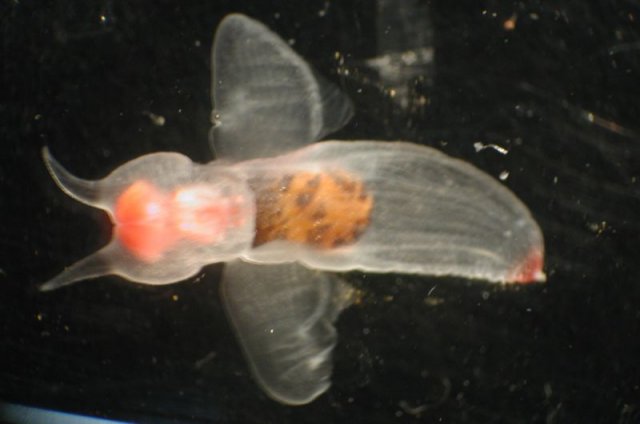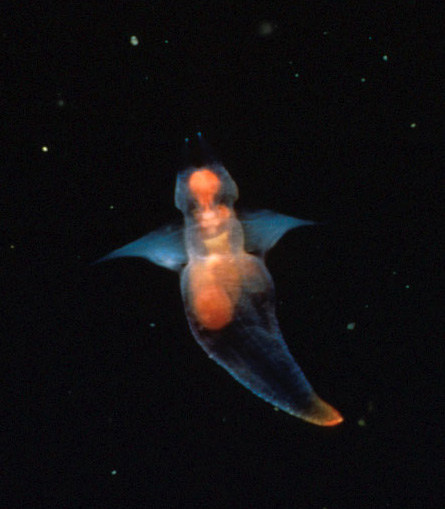Sea angels are small pteropod mollusks of the suborder Gymnosomata. Their feet have developed into wing-like appendages (parapodia) and their shells have been lost, both adaptations made to suit their free-swimming oceanic lives. These adaptations also explain the common name sea angel and the New Latin name of the order; from gymnos meaning "naked" and soma meaning "body." Within the order are approximately eight families and 17 genera.
Also known as gymnosomes, sea angels belong to the Orthogastropoda a subclass of Gastropoda (snails and slugs) which includes nudibranchs. The other suborder of pteropods, Thecosomata, are superficially similar but not closely related. They have larger, broader parapodia, most species retaining a shell, and are known commonly as sea butterflies.
Sea angels are gelatinous, mostly transparent and very small, with the largest species (Clione limacina) reaching 5 cm. Clione limacina is a polar species; those found in warmer waters are far smaller. Some species of sea angel feed exclusively on sea butterflies; the angels have terminal mouths with the radula common to mollusks, and tentacles to grasp their prey, sometimes with suckers similar to cephalopods. Their "wings" allow sea angels to swim much faster than the larger (usually fused) wings of sea butterflies. Other species of sea angel feed mostly on zooplankton.
Another large polar species of sea angel, Clione antarctica, defends itself from predators by synthesizing a previously unknown molecule, named pteroenone. As predators will not eat the sea angel some animals, such as amphipods, take up home inside them. Local population density of Clione antarctica may reach claustrophobic levels; up to 300 animals per cubic metre have been recorded.
Slowly beating their parapodia, sea angels gracefully fly through the upper 20 metres of the water column. Although usually slow-moving, they are capable of surprising bursts of speed. The animals are simultaneous hermaphrodites, fertilization occurring internally. A gelatinous egg mass is released during spawning, the eggs floating freely until hatching. Their embryonic shells are lost within the first few days after hatching.
Original article found here: http://en.wikipedia.org/wiki/Sea_angel

Also known as gymnosomes, sea angels belong to the Orthogastropoda a subclass of Gastropoda (snails and slugs) which includes nudibranchs. The other suborder of pteropods, Thecosomata, are superficially similar but not closely related. They have larger, broader parapodia, most species retaining a shell, and are known commonly as sea butterflies.
Sea angels are gelatinous, mostly transparent and very small, with the largest species (Clione limacina) reaching 5 cm. Clione limacina is a polar species; those found in warmer waters are far smaller. Some species of sea angel feed exclusively on sea butterflies; the angels have terminal mouths with the radula common to mollusks, and tentacles to grasp their prey, sometimes with suckers similar to cephalopods. Their "wings" allow sea angels to swim much faster than the larger (usually fused) wings of sea butterflies. Other species of sea angel feed mostly on zooplankton.
Another large polar species of sea angel, Clione antarctica, defends itself from predators by synthesizing a previously unknown molecule, named pteroenone. As predators will not eat the sea angel some animals, such as amphipods, take up home inside them. Local population density of Clione antarctica may reach claustrophobic levels; up to 300 animals per cubic metre have been recorded.
Slowly beating their parapodia, sea angels gracefully fly through the upper 20 metres of the water column. Although usually slow-moving, they are capable of surprising bursts of speed. The animals are simultaneous hermaphrodites, fertilization occurring internally. A gelatinous egg mass is released during spawning, the eggs floating freely until hatching. Their embryonic shells are lost within the first few days after hatching.
Original article found here: http://en.wikipedia.org/wiki/Sea_angel

Last edited by a moderator:



